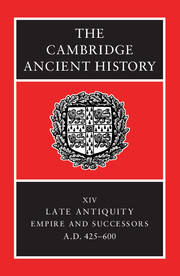Book contents
- Frontmatter
- PART I CHRONOLOGICAL OVERVIEW
- PART II GOVERNMENT AND INSTITUTIONS
- PART III EAST AND WEST: ECONOMY AND SOCIETY
- PART IV THE PROVINCES AND THE NON-ROMAN WORLD
- 18 The north-western provinces
- 19 Italy, A.D. 425–605
- 20 Vandal and Byzantine Africa
- 21a Asia Minor and Cyprus
- 21b Syria, Palestine and Mesopotamia
- 21c Egypt
- 22a The Sasanid monarchy
- 22b Armenia in the fifth and sixth century
- 22c The Arabs
- 23 The Balkans and Greece 420–602
- PART V RELIGION AND CULTURE
- Conclusion
- Chronological Table
- BIBLIOGRAPHY
- Index
- References
21b - Syria, Palestine and Mesopotamia
from PART IV - THE PROVINCES AND THE NON-ROMAN WORLD
Published online by Cambridge University Press: 28 March 2008
- Frontmatter
- PART I CHRONOLOGICAL OVERVIEW
- PART II GOVERNMENT AND INSTITUTIONS
- PART III EAST AND WEST: ECONOMY AND SOCIETY
- PART IV THE PROVINCES AND THE NON-ROMAN WORLD
- 18 The north-western provinces
- 19 Italy, A.D. 425–605
- 20 Vandal and Byzantine Africa
- 21a Asia Minor and Cyprus
- 21b Syria, Palestine and Mesopotamia
- 21c Egypt
- 22a The Sasanid monarchy
- 22b Armenia in the fifth and sixth century
- 22c The Arabs
- 23 The Balkans and Greece 420–602
- PART V RELIGION AND CULTURE
- Conclusion
- Chronological Table
- BIBLIOGRAPHY
- Index
- References
Summary
The eastern seaboard of the Mediterranean and its hinterland comprised some of the richest areas of the eastern Roman empire in late antiquity. Geographically, the area is most easily understood as a series of different climatic zones running north—south. Along the Mediterranean seaboard there is a well-watered strip which provides rich agricultural lands. In the north, this belt is comparatively narrow where the mountains of Syria and Phoenica Maritima come down almost to the sea. Only in a few places, like the vicinity of Antioch and inland from Tripolis, are there extensive fertile plains. In Palestine the fertile area becomes more extensive, though increasingly arid in the south. The mountains themselves vary greatly in character. In Syria II the mountains along the coast are poor and sparsely inhabited, and further south the high summits of Phoenicia Maritima form an effective barrier between coastal cities like Berytus and inland Damascus. In Palestine, on the other hand, the hills are gentler and more densely settled with villages and towns, including Jerusalem.
Inland, the rift valley runs all the way north–south from Syria I to Palestine III. In the north, where the Orontes flows through it, the rift valley is bordered on the east by the limestone massifs – rounded, rocky hills which supported intensive settlement in late antiquity. Further south, both the Biqa valley around Heliopolis (Baalbek) and the Jordan valley were well populated and included such important cities as Tiberias and Scythopolis (Baysān, Bet She’an). Even in the arid lands of the Wādī ’Araba south of the Dead Sea, the Byzantine period saw important settlements.
- Type
- Chapter
- Information
- The Cambridge Ancient History , pp. 588 - 611Publisher: Cambridge University PressPrint publication year: 2001
References
- 5
- Cited by

